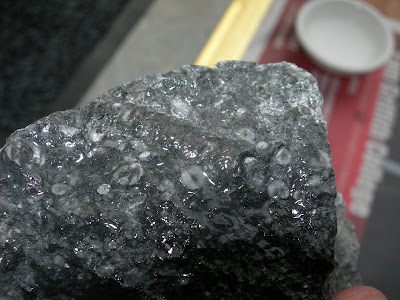Church Bay
Surf's Up!
What a view!
A sea slater (Ligia oceanica)
Cuttlefish eggs
A fine chert specimen
A belemnite
A brachiopod
A crinoid from Church Bay
 Song Thrush (T. philomelos)
Song Thrush (T. philomelos)
A guest post by Ken.
Date 110210
Today we went to Chruch Bay near Crosshaven to search again for more fossils and whatever else we could find. We were pleasantly surprised. Even before we reached the beach we we greeted by a song thrush (Turdus philomelos), an early offshoot of the Turdus lineage before they diversified and spread thoughout the world and so less closely related to the thrush species such as the blackbird (T. merula).
When we got to the beach we started our search and although at first we thought we had not gathered many fossils. On later inspection on a Carrigaline kitchen table we discovered a few of our old friends the belemnites (Belemnoidea cohort), the crinoids (Crinoidea class a.k.a. sea lilies) and brachiopods.
Then later, under a rock we found a sea slater (Ligia oceanica). It was noted by Alexander that they are nocturnal animals and can be easily caught at night. "Practice is needed to catch the animals because they can move with surprising speed and agility over very rough terrain" [Alexander C. G. (1972) Locomotion in the isopod crustacean, Ligia oceanica (Linn.) Comp. Biochem. Physiol. 42, 1039-1047]. We had no such issues and just picked up the rock. Take a look at this guy's peepers. he soon went his own way with all of his seven pairs of legs.
Later, we met a guy with a dog who said his mother grew up in Church Bay. He gave us a brief history of the area and explained that a lot of it was built by the British Army. Two pools were built, one for the women and one for the men but the beach itself he said has risen a lot over the years and so these pools would not be as deep. The surrounding cliff face had worn away quite bit also and he pointed out where you could see the old concrete foundation of a diving board. He said that a lot of college students called to this beach and although at first we thought it might have been because of the fossils although it looks more likely it was the meeting of both sandstone and limestone formations that is probably of geological interest to them.
What a day!
Later,
Ken.










No comments:
Post a Comment